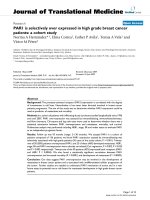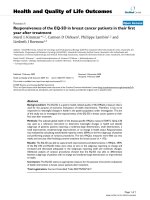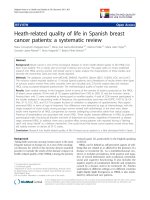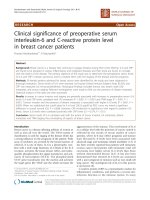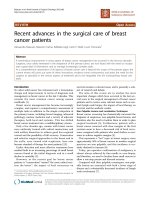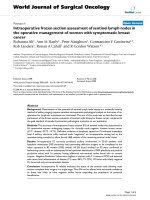Pharmacogenetics of doxorubicin in asian breast cancer patients
Bạn đang xem bản rút gọn của tài liệu. Xem và tải ngay bản đầy đủ của tài liệu tại đây (1.81 MB, 295 trang )
PHARMACOGENETICS OF DOXORUBICIN IN ASIAN
BREAST CANCER PATIENTS
SUMAN LAL CHIRAMMAL SUGUNAN
(MBBS, MSc)
A THESIS SUBMITTED
FOR THE DEGREE OF PHILOSOPHY
DEPARTMENT OF PHARMACOLOGY
NATIONAL UNIVERSITY OF SINGAPORE
200
8
ACKNOWLEDGEMENTS
The research done towards this thesis was carried out under the direct
supervision and guidance of Assoc Prof Balram Chowbay at the National
Cancer Centre, Singapore. I wish to deeply thank him for lending me his
support and guidance through each stage of the research and preparation of
this thesis. This would not have been possible without his persistence and
attention to detail. I am greatly indebted to my principal supervisor Prof
Edmund Lee at the National University of Singapore, whose generous
encouragement, guidance and support has been vital throughout the period of
my post-graduate study. Much gratitude is due to my laboratory colleagues
Xiaoxiang and Edwin, who have made significant experimental and analytical
contributions to this thesis. I am particularly thankful to Dr Zee Wan Wong and
other members of the breast cancer team from the Department of Medical
Oncology at the National Cancer Centre, who actively collaborated with the
Clinical Pharmacology Laboratory and provided vital clinical support for this
study. Last but not least, I would like to extend my sincere thanks and
gratitude to all the patients who have been involved in the study leading to this
thesis. This study was supported by research grants from the Singapore
Cancer Syndicate (Singapore Cancer Syndicate grant SCS-PS0023) and
SingHealth (SingHealth Research Fund SRF-SU110/2004).
. CONTENTS
ACKNOWLEDGEMENTS I
SUMMARY IX
PUBLICATIONS AND ABSTRACTS XII
LIST OF TABLES XV
LIST OF FIGURES XVIII
CHAPTER 1: INTRODUCTION 1
1.1 BREAST CANCER CHEMOTHERAPY 1
1.1.1 Incidence and Trends 1
1.1.2 Neo-adjuvant and Adjuvant Chemotherapy 1
1.1.3 Breast Cancer Chemotherapy Regimens 3
1.1.4 Anthracycline Based Chemotherapy 7
1.2 CLINICAL PHARMACOLOGY OF DOXORUBICIN 11
1.2.1 Introduction 11
1.2.2 Chemistry 11
1.2.3 Mechanism of Action 12
1.2.4 Pharmacokinetics 14
1.2.4.1 Administration and Distribution 14
1.2.4.2 Metabolism 15
1.2.4.3 Excretion 17
1.2.5 Pharmacodynamics 18
III
1.3 PHARMACOGENETICS OF DOXORUBICIN 23
1.3.1 Overview 23
1.3.2 Pharmacogenetics of Nuclear Receptors, Drug Transporters and Drug
Metabolizing Enzymes 25
1.3.2.1 Regulatory Nuclear Receptors 25
1.3.2.1.1 Pregnane X receptor (PXR) 26
1.3.2.2 Doxorubicin Efflux Transporters 29
1.3.2.2.1 ATP binding cassette, sub family B1 (ABCB1) 31
1.3.2.2.2 ATP binding cassette, sub family G2 (ABCG2) 34
1.3.2.2.3 ATP binding cassette, sub family B5 (ABCB5) 38
1.3.2.2.4 ATP binding cassette, sub family C5 (ABCC5) 40
1.3.2.2.5 Ral-Binding Protein 1; RALBP1 (RLIP76) 43
1.3.2.3 Doxorubicin Influx Transporters 47
1.3.2.3.1 Solute carrier family, member 16 (SLC22A16) 48
1.3.2.4 Doxorubicin Metabolizing Enzymes 50
1.3.2.4.1 Carbonyl Reductase 1 (CBR1) 51
1.3.2.4.2 Carbonyl Reductase 3 (CBR3) 52
1.4 STUDY HYPOTHESIS 54
1.5 OBJECTIVES 54
IV
CHAPTER 2: MATERIALS AND METHODS 56
2.1 STUDY DESIGN 56
2.2 STUDY POPULATION 57
2.2.1 Healthy Subjects 57
2.2.2 Breast Cancer Patients 57
2.2.2.1 Patient Definition 58
2.2.2.2 Inclusion Criteria 58
2.2.2.3 Exclusion Criteria 59
2.2.2.4 Screening Evaluations 59
2.2.2.5 Doxorubicin Administration and Dosing Schedule 60
2.2.2.6 Concomitant Therapy 61
2.2.3 Liver Tissues 61
2.3 CHEMICALS AND REAGENTS 63
2.4 PHARMACOGENETIC ANALYSIS 65
2.4.1 DNA Extraction 65
2.4.1.1 Whole Blood 65
2.4.1.2 Liver Tissues 66
2.4.2 Polymerase Chain Reactions (PCR) 67
2.4.3 Purification of PCR Fragments 70
2.4.4 DNA Sequencing 70
2.4.5 Pharmacogenetics of Nuclear Receptors 73
2.4.5.1 Pregnane X Receptor (PXR) 73
2.4.6 Pharmacogenetics of Doxorubicin Transporters 74
2.4.6.1 ATP binding cassette, sub family B1 (ABCB1) 74
2.4.6.2 ATP binding cassette, sub family G2 (ABCG2) 75
2.4.6.3 ATP binding cassette, sub family C5 (ABCC5) 76
2.4.6.4 ATP binding cassette, sub family B5 (ABCB5) 78
2.4.6.5 Ral-Binding Protein 1; RALBP1 (RLIP76) 80
V
2.4.6.6 Solute carrier family, member 16 (SLC22A16) 81
2.4.7 Pharmacogenetics of Doxorubicin Metabolizing Enzymes 82
2.4.7.1 Carbonyl Reductase 1 (CBR1) 82
2.4.7.2 Carbonyl Reductase 3 (CBR3) 83
2.5 HEPATIC EXPRESSION 84
2.5.1 RNA Extraction from Liver Tissues 84
2.5.2 Real Time Reverse-Transcription PCR (RT-PCR) 85
2.6 PHARMACOKINETICS OF DOXORUBICIN AND DOXORUBICINOL 87
2.6.1 High performance Liquid Chromatography (HPLC) Assay 87
2.6.1.1 Instrumentation and Chromatographic Conditions 87
2.6.1.2 Standard Stock Solution, Calibration and Quality Control
Samples 88
2.6.2 HPLC determination of Doxorubicin and Doxorubicinol 88
2.6.2.1 Sample Preparation and Analysis 88
2.6.2.2 Estimation of Pharmacokinetic Parameters 89
2.7 STATISTICAL ANALYSIS 92
2.7.1 Pharmacogenetic Analysis 92
2.7.2 Analysis of Hepatic Expression 92
2.7.3 Pharmacokinetic-Pharmacogenetic Correlations 93
VI
CHAPTER 3: RESULTS AND DISCUSSION 94
3.1 DEMOGRAPHICS OF ASIAN BREAST CANCER PATIENTS 94
3.2 PHARMACOKINETICS OF DOXORUBICIN 95
3.3 PHARMACOKINETICS OF DOXORUBICINOL 100
3.4 PHARMACOKINETIC-PHARMACOGENETIC CORRELATES OF
NUCLEAR RECEPTORS 105
3.4.1 Pregnane X Receptor (PXR) 105
3.4.1.1 PXR Pharmacogenetics 105
3.4.1.1.1 Linkage Disequilibrium and LD Blocks 110
3.4.1.1.2 PXR Haplotypes and Network Analysis 115
3.4.1.2 PXR Haplotypes and ABCB1 Hepatic Expression 120
3.4.1.3 Pharmacokinetic-Pharmacogenetic Associations 124
3.4.1.4 Discussion 126
3.5 PHARMACOKINETIC-PHARMACOGENETIC CORRELATES OF DRUG
TRANSPORTERS 133
3.5.1 ATP binding cassette, subfamily B1 (ABCB1) 133
3.5.1.1 ABCB1 Pharmacogenetics 133
3.5.1.2 Pharmacokinetic-Pharmacogenetic Associations 135
3.5.1.3 ABCB1 Hepatic Expression 141
3.5.1.4 Discussion 143
3.5.2 ATP binding cassette, subfamily G2 (ABCG2) 148
3.5.2.1 ABCG2 Pharmacogenetics 148
3.5.2.2 Pharmacokinetic-Pharmacogenetic Associations 148
3.5.2.3 ABCG2 Hepatic Expression 150
3.5.2.4 Discussion 151
3.5.3 ATP binding cassette, subfamily C5 (ABCC5) 154
VII
3.5.3.1 ABCC5 Pharmacogenetics 154
3.5.3.2 Pharmacokinetic-Pharmacogenetic Associations 156
3.5.3.3 ABCC5 Hepatic Expression 163
3.5.3.4 Discussion 166
3.5.4 ATP binding cassette, subfamily B5 (ABCB5) 169
3.5.4.1 ABCB5 Pharmacogenetics 169
3.5.4.2 Pharmacokinetic-Pharmacogenetic Associations 171
3.5.4.3 Discussion 172
3.5.5 Ral-Binding Protein 1; RALBP1 (RLIP76) 174
3.5.5.1 RLIP76 Pharmacogenetics 174
3.5.5.2 RLIP76 Hepatic Expression 174
3.5.5.3 Discussion 175
3.5.6 Solute carrier family, member 16 (SLC22A16) 177
3.5.6.1 SLC22A16 Pharmacogenetics 177
3.5.6.2 Pharmacokinetic-Pharmacogenetic Associations 179
3.5.6.3 SLC22A16 Hepatic Expression 182
3.5.6.4 Discussion 184
3.6 PHARMACOKINETIC-PHARMACOGENETIC CORRELATES OF DRUG
METABOLIZING ENZYMES 188
3.6.1 Carbonyl Reductase 1 (CBR1) 188
3.6.1.1 CBR1 Pharmacogenetics 188
3.6.1.1.1 Linkage Disequilibrium, Haplotypes and
Diplotypes 190
3.6.1.2 Pharmacokinetic-Pharmacogenetic Associations 193
3.6.1.3 CBR1 Hepatic Expression 199
3.6.2 Carbonyl Reductase 3 (CBR3) 201
3.6.2.1 CBR3 Pharmacogenetics 201
3.6.2.1.1 Linkage Disequilibrium, Haplotypes and
Diplotypes 204
3.6.2.2 Pharmacokinetic-Pharmacogenetic Associations 207
3.6.3 Discussion 207
VIII
CHAPTER 4: CONCLUSION AND FUTURE RESEARCH DIRECTIONS 214
A: APPENDIX 1 216
B: APPENDIX 2 218
BIBLIOGRAPHY 219
IX
SUMMARY
This thesis aimed to comprehensively evaluate the pharmacogenetics of the
regulatory nuclear receptor Pregnane-X Receptor (PXR), influx (SLC22A16) and
efflux drug transporters (ABCB1, ABCG2, ABCC5, ABCB5 and RLIP76) and drug
metabolizing enzymes (CBR1, CBR3) across the biochemical pathway of
doxorubicin in Asian breast cancer patients receiving doxorubicin based adjuvant
chemotherapy. The moderately linked ABCB1 1236CC-2677GG-3435CC
genotypes were associated with significantly increased exposure levels, peak
plasma concentrations and reduced clearance of doxorubicin in patients who were
homozygous for the variant alleles at the three ABCB1 loci. Breast cancer patients
homozygous for the ABCC5 g 1679T allele had significantly higher exposure
levels of doxorubicin when compared to the patients who were heterozygous for
the polymorphism. Three novel ABCB5 exonic polymorphisms [c.2T>C (exon 1),
c.343A>G (exon 2) and c.1573G>A (exon 12)] were identified among the healthy
Asian ethnic groups in the present study but showed no influence on doxorubicin
disposition in the Asian breast cancer patients. No significant influences of the
ABCG2 c.421C>A polymorphism on doxorubicin disposition was observed.
Screening the coding regions of the gene encoding Ral-Binding Protein 1
(RLIP76) among the three distinct Asian ethnic groups failed to identify any
polymorphic variations.
Four novel exonic polymorphisms were identified by direct sequencing of the
coding regions of the SLC22A16 gene [c.146A>G (exon 2), c.312T>C (exon 2),
c.755T>C (exon 4) and c.1226T>C (exon 5)]. Breast cancer patients harboring the
SLC22A16 c.146GG genotype showed a trend towards higher exposure levels to
X
doxorubicin and doxorubicinol compared to patients with either the reference
genotype or heterozygotes. With regards to doxorubicin metabolizing enzymes,
screening the exon and exon-intron boundaries of carbonyl reductase 1 (CBR1)
gene identified five polymorphisms (-48G>A, c.219G>C, c.627C>T, c.693G>A and
+967G>A) which exhibited significant inter-ethnic variations. The CBR1 D2
diplotypes were characterized by the presence of at least one variant allele at the
c.627C>T and +967G>A loci. Patients in the CBR1 D1 diplotype group had
significantly higher clearance and significantly lower exposure levels of doxorubicin
compared to patients belonging to the CBR1 D2 diplotype group. Five carbonyl
reductase 3 (CBR3) polymorphisms (c.11G>A, c.255T>C and c.279C>T,
c.606G>A and c.730G>A) were identified in Asian ethnic groups but did not reveal
any influence on doxorubicin disposition in breast cancer patients, possibly due to
its minimal tissue expression. Significant differences in the genotype and allele
frequencies of PXR polymorphisms and their linkage patterns among the Asian
ethnic groups were observed in the present study. Haplotype analysis revealed
that the PXR*1B haplotypes occurred at a higher frequency in Chinese (28.7%)
and Malays (35%) compared to Indians (19.4%) and was found to be associated
with significantly decreased hepatic mRNA expression of both PXR and also its
downstream target gene, ABCB1. The PXR*1B haplotype was found to be
associated with significantly reduced clearance of doxorubicin in Asian breast
cancer patients suggesting that genetic polymorphisms and specific haplotype
clusters in the PXR nuclear receptor could have significant contributory roles in
affecting interethnic variations in doxorubicin disposition.
XI
In conclusion, the findings of these studies showed that functional polymorphisms
in candidate genes across the doxorubicin biochemical pathway (PXR, ABCB1,
ABCC5, SLC22A16 and CBR1) may significantly contribute to the heterogeneity in
doxorubicin disposition among Asian breast cancer patients. It is conceivable that
the observed polygenic influence on doxorubicin pharmacogenetics may also
influence efficacy of doxorubicin in patients receiving adjuvant chemotherapy.
Development and independent validation of multi-compartmental pharmacokinetic-
pharmacodynamic models that succinctly incorporate both genetic and non-genetic
factors will be invaluable in definitively establishing the clinical utility of findings in
the present study on doxorubicin pharmacogenetics.
XII
PUBLICATIONS AND ABSTRACTS
PUBLICATIONS
1. Novel SLC22A16 polymorphisms and influence on doxorubicin
pharmacokinetics in Asian breast cancer patients. Suman Lal, ZW Wong, SR
Jada, X Xiang, XC Shu, PS Ang, Edmund JD Lee, B Chowbay.
Pharmacogenomics. 2007 Jun; 8(6):567-575.
2. The influence of ABCB1 and ABCG2 polymorphisms on doxorubicin
disposition in Asian breast cancer patients. Suman Lal, Wong ZW, Sandanaraj
E, Xiang X, PS Ang, Lee EJ, Chowbay B. Cancer Sci. 2008 Apr;99(4):816-23.
3. PXR pharmacogenetics and association of haplotypes with hepatic CYP3A4
and ABCB1 mRNA expression and doxorubicin clearance in Asian breast
cancer patients. Viknesvaran Selvarajan, Edwin Sandanaraj, Suman Lal, Zee
Wan Wong, Peter Cher Siang Ang, London Lucien Ooi, Balram Chowbay.
Clin Cancer Res. 2008 Nov 1;14(21):7116-26.
4. CBR1 and CBR3 pharmacogenetics and their influence on doxorubicin
disposition in Asian breast cancer patients. Suman Lal, Edwin Sandanaraj,
Xiaoqiang Xiang, Zee Wan Wong, Peter CS Ang, Wong Nan Soon, Edmund
JD Lee, Balram Chowbay. Cancer Sci. 2008 Oct;99(10):2045-54.
5. ABCB5, ABCC5 and RLIP76 Pharmacogenetics and Doxorubicin Disposition
in Asian Breast Cancer Patients. (Manuscript under submission)
XIII
ABSTRACTS
1. The European Cancer Conference, Italy 2007. Implications of the MDR1
c.1236C>T polymorphism: Influences on doxorubicin pharmacokinetics and
myelosuppression in Asian breast cancer patients. ZW Wong, S Lal, P Ang,
HT See, NS Wong, J Chia, YS Yap, KS Khoo, B Chowbay.
2. American Society of Clinical Oncology Breast Cancer Symposium, 2007,
USA. Influence of a of novel SLC22A16 c.146A>G polymorphism on
doxorubicin disposition in breast cancer patients. S Lal, ZW Wong, X Xiang, B
Chowbay.
3. American Association of Cancer Research Centennial Conference 2007,
Singapore. Pharmacogenetic profiling across the doxorubicin pathway in
Asian breast cancer patients. Edwin Sandanaraj, Suman Lal, X Xiang, Lee EJ,
B Chowbay.
4. American Society of Clinical Oncology, 2008, USA. Population
pharmacokinetics and pharmacogenetics profiling of doxorubicin and
doxorubicinol in Asian breast cancer patients. Sandanaraj Edwin, Radojka
Savic, Suman Lal, ZW Wong, CS Ang Peter, W Nam Soon, Nick Holford, Mats
O Karlsson, Balram Chowbay. J Clin Oncol 26: 2008 (May 20 suppl; abstr
13501)
5. American Society of Clinical Oncology, 2008, USA. Carbonyl Reductase 1
polymorphisms: Influence of Diplotype Structures on Doxorubicin disposition in
Asian Breast Cancer Patients. Lal S, Sandanaraj E, Xiang X, Wong ZW, Peter
CS Ang, Wong NS, Lee EJ, Chowbay B. J Clin Oncol 26: 2008 (May 20
suppl; abstr 14572)
XIV
6. Pharmacogenetics Meeting, 2008, Korea. PXR pharmacogenetics:
Association of haplotypes with hepatic CYP3A4 and ABCB1 mRNA expression
and doxorubicin clearance in Asian breast cancer patients. Selvarajan V,
Sandanaraj E, Lal S, Ooi LL, Wong ZW, Ang CSP, Lee EJD, Chowbay B.
(Abstract D1-20)
7. Japanese Cancer Association, Annual Meeting 2009. Pharmacogenetics
across the doxorubicin biochemical pathway in Asian breast cancer patients.
Suman Lal, Edwin Sandanaraj, Xiaoqiang Xiang, Zee Wan Wong, Nan Soon
Wong, Peter Cher Siang Ang, London Lucien Ooi, and Balram Chowbay.
XV
LIST OF TABLES
TABLE DESCRIPTIONS PAGE
Table 1.1 Combination chemotherapy regimens used in the
treatment of breast cancer
4
Table 2.1 List of chemicals, reagents and suppliers 62
Table 2.2 General components of the PCR kit core reagents used for
pharmacogenetic analysis of various genes
67
Table 2.3 Standard components of individual PCR reactions for
pharmacogenetic analysis of various genes
67
Table 2.4 Primers and PCR conditions used for sequence analysis
of PXR gene polymorphisms
71
Table 2.5 PCR primers and conditions used for genotyping ABCB1
polymorphisms
72
Table 2.6 PCR primers and conditions used for genotyping the
ABCG2 c.421C>A polymorphism
73
Table 2.7 PCR primers and conditions used for genotyping ABCC5
polymorphisms
75
Table 2.8 PCR primers and conditions used for amplifying ABCB5
exon and exon-intron regions
77
Table 2.9 PCR primers and conditions used for amplification of
RLIP76 exon and exon-intron regions
78
Table 2.10 PCR primers and conditions for amplification of SLC22A16
exon and exon-intron regions
79
Table 2.11 PCR primers and conditions used for amplification of
CBR1 exon and exon-intron regions
80
Table 2.12 PCR primers and conditions used for amplification of
CBR3 exon and exon-intron regions
81
Table 2.13 RT-PCR primers used for hepatic expression analysis of
drug transporters and drug metabolizing enzymes in
Chinese liver tissues
84
XVI
TABLE DESCRIPTIONS PAGE
Table 2.14 Plasma pharmacokinetic parameters analyzed for
doxorubicin and doxorubicinol
88
Table 3.1 Demographics of Asian breast cancer patients 92
Table 3.2 Summary of doxorubicin and doxorubicinol
pharmacokinetic parameters in Asian breast cancer
p
atients
93
Table 3.3 Genotype and allele frequencies of PXR gene
polymorphisms in Asian healthy subjects and breast
cancer
p
atients
105
Table 3.4 PXR haplotype and haplotype families among Asian ethnic
groups
115
Table 3.5 PXR genotype and allele frequencies in Chinese healthy
liver tissues
119
Table 3.6 PXR haplotype clusters and pharmacokinetics of
doxorubicin and doxorubicinol in Asian breast cancer
p
atients
123
Table 3.7 Genotype and allele frequencies of ABCB1 polymorphisms
in Asian breast cancer patients
132
Table 3.8 ABCB1 polymorphisms and pharmacokinetics of
doxorubicin and doxorubicinol in Asian breast cancer
p
atients
135
Table 3.9 The influence of ABCB1 linked polymorphisms on the
pharmacokinetics of doxorubicin and doxorubicinol in
A
sian breast cancer
p
atients
137
Table 3.10 ABCB1 genotype frequencies in Asian healthy liver tissues
and influence on ABCB1 mRNA levels
140
Table 3.11 Genotype and allele frequencies of ABCG2
polymorphisms in Asian breast cancer patients
147
Table 3.12 ABCG2 polymorphisms and pharmacokinetics of
doxorubicin and doxorubicinol in Asian breast cancer
p
atients
147
Table 3.13 ABCG2 genotype frequencies in Chinese healthy liver
tissues and influence on ABCG2 mRNA levels.
148
Table 3.14 Genotype and allele frequency of ABCC5 polymorphisms
in Asian breast cancer patients.
153
Table 3.15 The influence of ABCC5 polymorphisms on
pharmacokinetics of doxorubicin and doxorubicinol in
Asian breast cancer patients
155
XVII
TABLE DESCRIPTIONS PAGE
Table 3.16 ABCC5 genotype and allele frequencies in Chinese
healthy liver tissues and influence on ABCC5 mRNA
levels.
162
Table 3.17 ABCB5 exon polymorphisms 168
Table 3.18 Genotype and allele frequency of ABCB5 polymorphisms
in healthy subjects and Asian breast cancer patients
168
Table 3.19 The influence of ABCB5 polymorphisms on
pharmacokinetics of doxorubicin and doxorubicinol in
A
sian breast cancer
p
atients
169
Table 3.20 SLC22A16 exon polymorphisms 169
Table 3.21 Genotype and allele frequency of SLC22A16
polymorphisms
171
Table 3.22 The influence of SLC22A16 polymorphisms on the
pharmacokinetics of doxorubicin and doxorubicinol in
A
sian breast cancer
p
atients
179
Table 3.23 SLC22A16 genotype frequencies in Chinese healthy liver
tissues and influence on SLC22A16 mRNA levels
180
Table 3.24 Genotype and allele frequency of CBR1 polymorphisms in
Asian ethnic groups and breast cancer patients
187
Table 3.25 CBR1 haplotypes and diplotypes in Asian ethnic groups
and breast cancer patients
190
Table 3.26 The influence of CBR1 polymorphisms on
pharmacokinetics of doxorubicin and doxorubicinol in
A
sian breast cancer
p
atients
193
Table 3.27 The influence of CBR1 diplotypes on pharmacokinetics of
doxorubicin and doxorubicinol in Asian breast cancer
p
atients
195
Table 3.28 CBR1 genotype frequencies in Chinese healthy liver
tissues and influence on CBR1 mRNA levels
197
Table 3.29 Genotype and allele frequency of CBR3 polymorphisms in
Asian ethnic groups and breast cancer patients
201
Table 3.30 CBR3 haplotypes and diplotypes in Asian ethnic groups
and breast cancer patients
203
XVIII
LIST OF FIGURES
FIGURE DESCRIPTIONS PAGE
Figure 1.1 Guidelines for systemic adjuvant therapy in breast cancer 7
Figure 1.2 Chemical structure of doxorubicin 12
Figure 1.3 The metabolic pathway of doxorubicin 16
Figure 1.4 Potential determinants of doxorubicin pharmacodynamic
effects
20
Figure 1.5 Major pharmacogenetic candidates across the doxorubicin
biochemical pathway
23
Figure 1.6 Structure of ABC transporters showing the
transmembrane domains (TMD) and nucleotide binding
domains (NBD)
29
Figure 3.1 Plasma concentration-time profile of doxorubicin in Asian
breast cancer patients
94
Figure 3.2 Plasma concentration-time profile of doxorubicinol in
Asian breast cancer patients
99
Figure 3.3 Pairwise linkage disequilibrium of PXR polymorphisms
and LD blocks in Chinese population.
110
Figure 3.4 Pairwise linkage disequilibrium of PXR polymorphisms
and LD blocks in Malay population.
111
Figure 3.5 Pairwise linkage disequilibrium of PXR polymorphisms
and LD blocks in Indian population.
112
Figure 3.6 PXR haplotype families and tagged polymorphisms in (A)
Chinese, (B) Malay and (C) Indian ethnic groups
117
Figure 3.7 Inter-individual variability in PXR expression among
Chinese healthy liver tissues.
118
Figure 3.8 Hepatic expression of PXR (A) and ABCB1 (B) in relation
to PXR haplotype families.
121
XIX
FIGURE DESCRIPTIONS PAGE
Figure 3.9 Pairwise linkage disequilibrium (LD) between the ABCB1
c.1236C>T, c.2677G>T/A and c.3435C>T polymorphisms
in Asian cancer patients
132
Figure 3.10 The influence of the ABCB1 genotypes on the A)
exposure levels [AUC
0-∞
/dose/BSA(hm
-5
)] and B)
clearance [CL/BSA(Lh
-1
m
-2
) ] of doxorubicin
138
Figure 3.11 Inter-individual variability in ABCB1 expression in Chinese
healthy liver tissues
140
Figure 3.12 Inter-individual variability in ABCG2 expression in Chinese
healthy liver tissues
148
Figure 3.13 Inter-individual variability in ABCC5 expression in Chinese
healthy liver tissues
161
Figure 3.14 Inter-individual variability in RLIP76 expression in Chinese
healthy liver tissues.
172
Figure 3.15 Inter-individual variability in SLC22A16 expression in
Chinese healthy liver tissues
181
Figure 3.16 Pairwise linkage disequilibrium among CBR1
polymorphisms in Asian breast cancer patients
191
Figure 3.17 CBR1 diplotype groups observed in Asian breast cancer
patients
194
Figure 3.18 The influence of the CBR1 diplotypes on the A) clearance
[CL/BSA(Lh
-1
m
-2
) ] and B) exposure levels [AUC
0-∞
/dose/
BSA(hm
-5
)] of doxorubicin in Asian breast cancer patients
196
Figure 3.19 Inter-individual variability in CBR1 expression in Chinese
healthy liver tissues
198
Figure 3.15 Pairwise linkage disequilibrium among CBR3
polymorphisms in Asian breast cancer patients
204
1
CHAPTER 1: INTRODUCTION
1.1 BREAST CANCER CHEMOTHERAPY
1.1.1 Incidence and Trends
Breast cancer accounts for one third of all cancers in women and is the most
prevalent cancer diagnosed among women around the world, occurring with a
lifetime risk of one in eight.
(1,2)
The incidence of breast cancer is continuously
increasing, with more than 1,000,000 cases diagnosed each year
worldwide.
(3,4)
Detection of disease at an earlier stage and appropriate
administration of systemic therapy in conjunction with conservative surgery
and radiation has improved survival and decreased the morbidity and
mortality of breast cancer patients.
5
Although the number of effective
treatments for breast cancer is on the rise, the benefit from specific treatments
to individual patients and the adverse effects experienced vary considerably
depending on tumor, treatment and host characteristics. Following the
increasingly integrated study of the genetic, molecular, biochemical and
cellular basis of breast cancer and its treatment, the field of breast cancer
research is now intensely involved in elucidating the molecular basis of
variations in clinical response and mechanisms of resistance to treatment.
1.1.2 Neo-adjuvant and Adjuvant Chemotherapy
Chemotherapy involving the use of cytotoxic agents is an important strategy in
the management of patients with malignant tumors, complimented by
2
radiotherapy and surgery.
(6)
Neoadjuvant or induction chemotherapy refers to
the administration of anticancer agents prior to local therapy and is aimed at
decreasing tumor size, rendering them more amenable to surgery.
(7,8)
The
main clinical indication for neoadjuvant treatment in breast cancer is the
downstaging of tumors, allowing either mastectomy in cases initially thought
to be inoperable, or allowing breast-conserving surgery in cases initially
thought suitable for mastectomy as the only surgical option.
(9)
The clinical
response rate to neoadjuvant chemotherapy varies between 30 to 90%
(10,11,12)
and the five year overall survival rate is reported to range between 40 and
80%.
(10,13,14)
A pathological complete response (pCR) to neoadjuvant
chemotherapy is a clear-cut predictor of survival, occurring in 3 to 6% of
patients.
(15)
Several trials of neoadjuvant chemotherapy have shown an
increase in the rate of breast conservation, and preoperative systemic
treatment is now an established component in the management of large,
potentially operable and locally advanced breast cancers.
(16,17)
Adjuvant chemotherapy involves drug administration after removal of the
primary tumor when there is no evidence of residual disease, and is based on
studies showing an inverse relationship between chemotherapeutic response
and the number of tumor cells.
(18,19)
The benefits of adjuvant chemotherapy as
a successful addition to locoregional treatment seem to be greater in younger
women.
(20)
Below the age of 50, the absolute gain at 10 years is 4.5% and
11.3% in node negative and node positive patients, respectively, whereas in
women aged 50 to 69, a smaller though still significant gain (3.2% and 3%
respectively) is observed.
(21,22)
Women in the 50-69 age group have been
reported to achieve a 20% proportional reduction in the risk of recurrence and
3
an 11% proportional reduction in the risk of death following adjuvant
chemotherapy
22
while demonstration of a modest but sustained and
significant impact on survival gain has also been shown in women aged < 70
years with moderate to high risk breast cancer.
23
These benefits of adjuvant
chemotherapy have been observed to be independent of the estrogen
receptor (ER) status of the primary tumors and of the use of adjuvant
tamoxifen.
24
1.1.3 Breast Cancer Chemotherapy Regimens
The Early Breast Cancer Trialist’s Collaborative Group (EBCTCG) study
summarized the results of all randomized adjuvant chemotherapy trials that
began before 1990, concluding that combination chemotherapy in breast
cancer improved long term relapse free and overall survival rates in women
up to 70 years of age irrespective of nodal status or estrogen receptor (ER)
status.
22
Combination chemotherapy that uses two or more drugs appeared to
be superior to single agents; with four to six cycles of treatment (3-6 months)
considered optimal.
(25)
The current combination chemotherapy regimens used
in the treatment of breast cancer are summarized in Table 1.1. The higher cell
killing achieved due to non-overlapping toxicity of the component drugs and
the tumor cell heterogeneity that vary in terms of drug sensitivity and
resistance are considered important factors in the success of combination
chemotherapy regimens.
4
Table 1.1 Combination chemotherapy regimens used in the treatment of
breast cancer.
Regimen Agents and doses used Overall duration
AC A: Doxorubicin 60 mg/m
2
IV d1, and 12 week:
C: Cyclophosphamide 600 mg/m
2
IV d1 Every 21 d x 4 cycles
CAF
C: Cyclophosphamide 100 mg/m
2
po d1–14,
d
24 week:
A: Doxorubicin, 30 mg/m
2
IV d1, d8, and Every 28 d x 6 cycles
F: Fluorouracil, 500 mg/m
2
IV d1, d8
CMF
C: Cyclophosphamide 100 mg/m
2
po d 1–14,
d
24 week:
M: Methotrexate, 40 mg/m
2
IV d1, d 8, and Every 28 d x 6 cycles
F: Fluorouracil, 500 mg/m
2
IV d1, d 8
AC > T A: Doxorubicin 60mg/m
2
IV d1, and 24 week:
C: Cyclophosphamide 600 mg/m
2
IV d1 Every 21 d x 4 cycles;
Followed by: Every 21 d x 4 cycles
T: Paclitaxel 175 mg/m
2
IV over 3h or
Docetaxel 100 mg/m
2
IV over 1h
Dose dense
AC < T
A: Doxorubicin 60mg/m
2
IV d1, and 16 week:
C: Cyclophosphamide 600 mg/m
2
IV d1 Every 14 d x 4 cycles
Followed by: Every 14 d x 4 cycles
T: Paclitaxel 175 mg/m
2
IV over 3h or
Docetaxel 100 mg/m
2
IV over 1h
CEF C: Cyclophosphamide 500 mg/m
2
IV d1, and 12 week:
E: Epirubicin 100 mg/m
2
IV d1, and Every 21 d x 6 cycles
F: Flourouracil 500 mg/m
2
IV d1
MF M: Methotrexate 100 mg/m
2
IV d1, d8, and 24 week:
F: Flourouracil 600 mg/m
2
IV d1, d 8 Every 28 d x 6 cycles
TAC T: Docetaxel 75 mg/m
2
IV d1, and 24 week:
A: Doxorubicin 50 mg/m
2
IV d1, and
C: Cyclophosphamide 500 mg/m
2
IV, d1 Every 21 d x 6 cycles
Adapted from: Rock and DeMichele et al.
(26)
The combination of alkylating agent cyclophosphamide with two
antimetabolites, methotrexate and fluorouracil (CMF), was established as the
gold standard for adjuvant therapy of breast cancer in the mid 1970s.
(27,28)
Studies showed that there was a significant reduction in recurrence rates in
5
patients on anthracycline regimens (P = 0.006), and a modest but significant
improvement in 5-year survival (72% with anthracycline v 69% with CMF
regimen; P = 0.02).
(29,30)
Later, the addition of taxanes (paclitaxel or
docetaxel) to anthracycline-containing regimens were reported to give
additional survival benefit with an absolute gain of 2-7% in randomized
trials.
(31)
Paclitaxel is usually administered for four cycles after doxorubicin
and cyclophosphamide (every 3 weeks) or as a 'dose-dense' regimen (every 2
weeks) with growth factor (G-CSF) support in between cycles.
(32,33)
Docetaxel
is given as part of the TAC12 regimen (taxotere, adriamycin, and
cyclophosphamide) every 3 weeks with growth factor support or three 3-
weekly cycles following three cycles of FEC (5-fluorouracil, epirubicin, and
cyclophosphamide).
(34)
The five-year disease free survival (DFS) rates were
73.2% and 78.4% (FEC and FEC-D regimens, respectively) whereas five-
year overall survival rates were 86.7% and 90.7% (FEC and FEC-D regimens,
respectively), demonstrating a 27% reduction in the relative risk of death.
(34)
Human epidermal growth factor receptor-2 (Her2-neu) overexpression is seen
in 20-30% of breast cancers and tend to occur in poorly differentiated (grade-
3), ER-negative and node-positive tumors.
(35)
The overexpression of Her2-neu
correlates with poor prognosis, shorter overall survival, and altered response
to hormonal therapy and chemotherapy.
(36,37)
Trastuzumab is a humanised
monoclonal antibody directed against the external domain of the Her2-neu
receptor and has clinical activity as a single agent in patients whose cancers
overexpress Her2-neu.
(38)
Large-scale randomized studies have been
conducted to evaluate the use of trastuzumab in the adjuvant setting.
(39)
Following trials that showed dramatic improvement of response rates when
